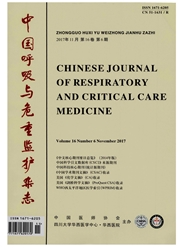

 中文摘要:
中文摘要:
目的比较三条LBP/CD14结合位点模拟肽体外抑制内毒素性炎症反应的生物学活性。方法采用酶联免疫吸附法(ELISA)检测模拟肽与CD14的亲和力及与脂多糖结合蛋白(LBP)的竞争性抑制活性。将佛波脂(PMA)诱导成熟的U937细胞与内毒素共培养,并予以模拟肽干预,采用RT-PCR检测模拟肽对U937细胞TNF-α基因表达的影响。将大鼠肺泡巨噬细胞(AMs)与荧光标记内毒素(FITC-LPS)共培养,并予以模拟肽干预,采用荧光显微镜观测模拟肽对内毒素(LPS)与AMs结合的影响。结果1号模拟肽(FHRWPTWPLPSP,10μg/mL)与CD14的亲和力显著高于2号和3号模拟肽(20.3±4.1比11.8±2.4和13.7±3.3,P〈0.01或P〈0.05),1号模拟肽(10μg/mL)对LBP的竞争性抑制活性也显著高于2号和3号模拟肽[(57.2±11.2)%比(39.4±9.7)%和(37.9±8.3)%,P均〈0.01]。三条模拟肽(10μg/mL)均可从基因水平显著抑制LPS诱导U937细胞产生TNF-α(P〈0.01或P〈0.05),1号模拟肽的抑制作用显著强于2号和3号模拟肽(0.239±0.053比0.406±0.112和0.493±0.121,P〈0.01)。1号模拟肽能显著抑制LPS与AMs结合(2 157±514比2 763±453,P〈0.01)。结论1号模拟肽(FHRWPTWPLPSP)有较高的CD14亲和力及LBP竞争性抑制活性,具有潜在的抗内毒素性炎症反应的作用。
 英文摘要:
英文摘要:
Objective To compare the in vitro inhibition activity of three mimic peptides at lipopolysaeeharide binding protein ( LBP )/CD14 binding sites for LPS-induced inflammatory response. Methods Enzyme-linked immunosorbent assay (ELISA) was applied for the detection of the affinity between the mimic peptides and CD14 as well as the competitive inhibition activity of LBP. Mature U937 cells induced by PMA were co-cultured with LPS and intervened by mimic peptide. The effect of the mimic peptide on the TNF-α expression of U937 was detected by RT-PCR. Alveolar macrophages(AMs) of rats were co-cultured with FITC-LPS, and mimic peptide intervention was conducted. The effect of the mimic peptide on eombination of LPS and AMs was observed by fluoreseenee microscope . Results Affinity between No. 1 mimic peptide (FHRWPTWPLPSP, 10 μg/mL)and CD14 was significantly higher than those of No. 2 and No. 3(20.3 ±4.1 vs 11.8 ±2.4 and 13.7 ±3.3,P〈0.01 or P〈0.05).The competitive inhibitory activity of No. 1 mimic peptide( 10 μg/mL) for LBP was higher than those of No. 2 and No. 3 [ (57.2 ± 11.2) % vs (39. 4 ± 9. 7) % and (37.9 ± 8.3 ) %, P 〈 0. 011. All of the three mimic peptides( 10 μg/mL) could significantly inhibit the LPS-indueed expression of TNF-α by U937 at mRNA level(P 〈0. 01 or P 〈0.05) ,moreover,the inhibitory activity of No. 1 peptide was the highest(0. 239 ±0. 053 vs 0. 406 ± 0. 112 and 0. 493 ± 0. 121, P 〈 0.01 ). In addition, No. 1 mimic peptide markedly inhibited LPS combination with rat lung AMs (2157 ± 514 vs 2763 ± 453, P 〈 0. 01 ). Conclusion No. 1 mimic peptide ( FHRWPTWPLPSP ) have a relatively higher affinity with CD14 and high competitive inhibition activity for LBP, therefore it have the potential ability of anti-inflammatory response induced by LPS.
 同期刊论文项目
同期刊论文项目
 同项目期刊论文
同项目期刊论文
 期刊信息
期刊信息
